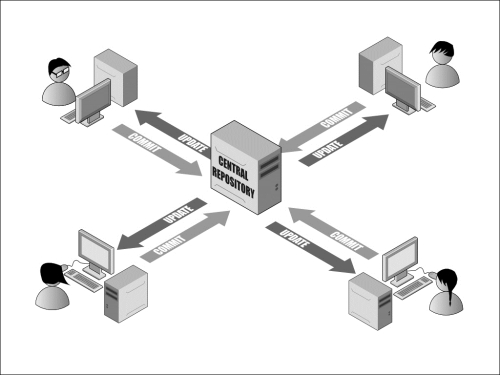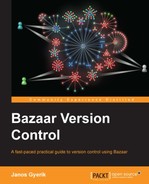- Bazaar Version Control
- Table of Contents
- Bazaar Version Control
- Credits
- About the Author
- About the Reviewers
- www.PacktPub.com
- Preface
- 1. Getting Started
- 2. Diving into Bazaar
- Understanding the core concepts
- Introducing the user interfaces
- Configuring Bazaar
- Performing the basic version control operations
- Putting a directory under version control
- Checking the status of files and directories
- Adding files to version control
- Recording a new revision
- Ignoring files
- Deleting files
- Undoing changes
- Editing files
- Viewing differences in changed files
- Renaming or moving files
- Viewing the revision history
- Restoring files from a past revision
- Putting it all together
- Beyond the basics
- Summary
- 3. Using Branches
- What is a branch?
- What can you do with branches?
- Why use more than one branch?
- Understanding core terms and concepts
- Using a shared repository
- Basic branching and merging
- Using the branch command
- Viewing basic branch information
- Comparing branches
- Merging branches
- Mirroring branches
- Summary
- 4. Using Bazaar in a Small Team
- Collaborating with others
- Sharing branches over the network
- Working with remote branches
- Implementing simple workflows
- Summary
- 5. Working with Bazaar in Centralized Mode
- 6. Working with Bazaar in Distributed Mode
- The distributed mode in general
- The human gatekeeper workflow
- The automatic gatekeeper workflow
- The shared mainline workflow
- Choosing a distributed workflow
- Summary
- 7. Integrating Bazaar in CDE
- What is a CDE?
- Working with Launchpad
- Integrating Bazaar into Redmine
- Integrating Bazaar into Trac
- Linking commits to bug trackers
- Web-based repository browsing with Loggerhead
- Summary
- 8. Using the Advanced Features of Bazaar
- 9. Using Bazaar Together with Other VCS
- Working with other VCS in general
- Using Bazaar with Subversion
- Installing bzr-svn
- Supported protocols and URL schemes
- Using the example Subversion repository
- Understanding branches in Subversion
- Branching or checkout from Subversion
- Preserving Subversion metadata
- Pulling or updating from Subversion
- Committing to Subversion
- Pushing to Subversion
- Merging Subversion branches
- Merging local branches into Subversion
- Binding and unbinding to Subversion locations
- Using lightweight checkouts
- Browsing the logs
- Limitations of bzr-svn
- Final remarks on bzr-svn
- Using Bazaar with Git
- Migrating between version control systems
- Summary
- 10. Programming Bazaar
- Using Bazaar programmatically
- Creating a plugin
- Using the example plugins
- Naming the plugin
- Creating the plugin directory
- Implementing the plugin
- Writing the README file
- Creating __init__.py
- Writing unit tests
- Creating setup.py
- Browsing existing plugins
- Registering your plugin
- Creating a hook
- References
- Summary
- Index
Centralized version control systems were created to make it possible for multiple collaborators to work on projects together. In these systems, the history of revisions is stored on a central server, and all the version control operations by all collaborators must go through this server. If a collaborator records a new revision, then all other collaborators can download and apply the revision in their own environments to update their project to the same state as the central server:

To avoid conflicting changes on the same file by multiple collaborators, such as concurrent modifications to the same lines, collaborators have to work in lockstep—after collaborator A has made some changes, collaborator B must first download those changes before he can add any new changes of his own.
Thanks to its simplicity, this is still a very popular workflow today, used by many large and famous projects and organizations. However, despite their popularity, centralized systems have serious drawbacks:
- Network access to the central server is required for all the operations that change the repository or access the revision history. As such, network outage and slowness can seriously impact productivity.
- The central server is a single point of failure—if the server is unavailable or lost, so is the revision history of the entire project.
- Administrative overhead—to prevent unauthorized access, user account and permission management must be configured and maintained.
-
No Comment
